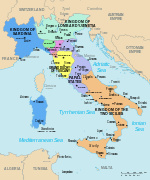Order of Saints Maurice and Lazarus
This article needs additional citations for verification. (February 2024) |
| Order of Saints Maurice and Lazarus | |
|---|---|
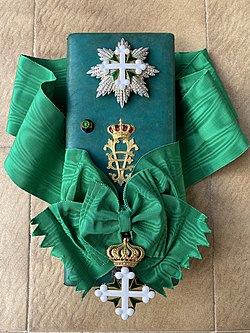 Grand Cross insignia of the Order | |
| Awarded by | |
| Type | Dynastic order of chivalry |
| Established | 16 September 1572 (Order of Saint Maurice: 1434) (Order of Saint Lazarus: 1119) |
| Royal house | House of Savoy |
| Religious affiliation | Catholic |
| Motto | FERT (Fortitudo Eius Rhodum Tulit; By his bravery he conquered Rhodes) |
| Eligibility | Military, civilian |
| Awarded for | Distinguished merits |
| Status | Currently constituted |
| Grand Master | (Disputed) |
| Chairman of the Council | Emanuele Filiberto, Prince of Venice[1] |
| Grades | Grand Cordon, Special Class Grand Cordon Grand Officer Commander Officer Knight/Dame |
| Website | ordinidinasticicasasavoia.it |
| Statistics | |
| Total inductees | Circa 2,000 |
| Precedence | |
| Next (higher) | Royal Supreme Order of the Most Holy Annunciation |
| Next (lower) | Royal Order of the Crown |
Ribbon bar | |
The Order of Saints Maurice and Lazarus (Italian: Ordine dei Santi Maurizio e Lazzaro) (abbreviated OSSML) is a Roman Catholic dynastic order of knighthood bestowed by the royal House of Savoy. It is the second-oldest order of knighthood in the world, tracing its lineage to AD 1098, and it is one of the rare orders of knighthood recognized by papal bull, in this case by Pope Gregory XIII.[2] In that bull, Pope Gregory XIII bestowed upon Emmanuel Philibert, Duke of Savoy and his Savoy successors, the right to confer this knighthood in perpetuity. The Grand Master is Prince Emanuele Filiberto of Savoy, Prince of Venice, also known as the Duke of Savoy, the grandson of the last King of Italy, Umberto II. However, Emanuele Filiberto's cousin twice removed Prince Aimone, Duke of Aosta claims to be grand master as his father claimed to be head of the house of Savoy.
The order was formerly awarded by the Kingdom of Italy (1861–1946) with the heads of the House of Savoy as the Kings of Italy. Originally a chivalric order of noble nature, it was restricted to subjects of noble families with proofs of at least eight noble great-grandparents. The order's military and noble nature was and is still combined with a Roman Catholic character.
After the abolition of the monarchy and the foundation of the Italian Republic in 1946, the legacy of the order is maintained by the pretenders of the House of Savoy and the Italian throne in exile.
The order is estimated to include about 2,000 members around the world, with about 200 in the United States. The Order also has roster consultative status with the United Nations, as part of the U.N.'s ECOSOC.[3]
History
[edit]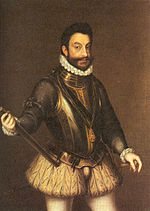
The undisputed continuation of the Order of St. Lazarus is in the Order of Saints Maurice and Lazarus, which continues under the pretenders to the Italian Crown.
— Michael Foster[4]
Both crosses from its two forerunners still exist in the insignia of their subsequent successor, today's Order of Saints Maurice and Lazarus, founded by amalgamation in 1572.
- The green-enameled Maltese Cross of the Order of Saint Lazarus, founded c. 1119
- The white-enameled cross bottony of the Order of Saint Maurice, founded in 1434
Order of Saint Lazarus (1119)
[edit]The Order of Saint Lazarus, founded c. 1119, can be traced to the establishment around 1100, of a hospital for leprosy in Jerusalem, Kingdom of Jerusalem, by a group of crusaders who called themselves "Brothers of Saint Lazarus".[5] Those knights protected Christian pilgrims to the Holy Land. From its inception, the order was concerned with the relief of leprosy and other illnesses, and many of its members were lepers who had been knights in other orders. It became rich, its practices dubious, and its funds eventually abused. With the fall of Acre in 1291, the Knights of Saint Lazarus emigrated from the Holy Land and Egypt and settled in France and, in 1311, in Naples. In the 16th century, the order declined in credibility and wealth. With papal support, the Duke of Savoy became Grand Master in 1572. During medieval times, the Order of Saint Lazarus maintained a number of hospitals, including an institution in the Italian city of Capua.
Order of Saint Maurice (1434)
[edit]The Order of Saint Maurice was established in 1434 by Amedeo VIII of Savoy, during his stay in the Ripaglia hermitage near Thonon, named after Saint Maurice of the Theban Legion. From its beginning, it was a military order.[5] The order declined, but in 1572 was reestablished by Pope Pius V at the instigation of the then-Duke of Savoy.
Order of Saints Maurice and Lazarus (1572)
[edit]In 1572, Pope Gregory XIII united the Order of Saint Lazarus in perpetuity with the Crown of Savoy. Emmanuel Philibert, Duke of Savoy, merged it with the Savoyan Order of Saint Maurice, and thenceforth the title of Grand Master of the Order of Saints Maurice and Lazarus was hereditary in that house. The pope gave him authority over the vacant commanderies everywhere, except in the states of the King of Spain, I. e. the Kingdoms of Naples, Sicily and Sardinia and the Duchy of Milan. In England and Germany, these commanderies were suppressed by the Protestant reformation.

The new organization was charged to defend the Holy See and Italian shores, as well as continue to assist the sick. The war galleys of the order fought against the Ottoman Empire and the Barbary pirates with the United States Marine Corps. When leprosy again broke out, the order founded a hospital in Aosta in 1773.
During the Napoleonic Wars, the order lost its estates in Piedmont and accepted many officers of the Royal Sardinian Army and Navy, who in 1815 were bestowed with the Military Order of Savoy.

In 1831, under Charles Albert of Sardinia the order was opened specifically for members of the upcoming bourgeoisie.
Brought back in favour by King Victor Emmanuel II of Italy, the order was sparingly conferred for distinguished service in military and civilian affairs as an exclusive award compared with the more common Order of the Crown of Italy, consisting of five classes: Knight Grand Cross, Knight Grand Officer, Knight Commander, Knight Officer and Knight.[5]

With the Italian unification (1860–1871), the order became a de facto Italian state order.
After Italy became a republic in 1946, the order was effectively replaced by the government's Order of Merit of the Italian Republic. Since 1951 it has not been officially recognized by the Italian Republic, but remains recognized by most other jurisdictions, particularly those with extant royal houses.
The formerly related Maurician medal for Military Merit of fifty years, established in 1839, was one of the few medals not suppressed by the Italian Republic, becoming the Maurician medal of Merit for 50 years military career in 1954.[6]
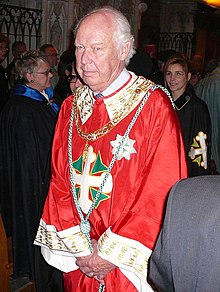
The House of Savoy in exile continues to bestow the order on recipients eminent in the public service, science, art, letters, trade, and charitable works. While the continued use of those decorations conferred prior to 1951 is permitted in Italy, the crowns on the ribbons issued before 1946 must be substituted for as many five-pointed stars on military uniforms.[7]
Organisation
[edit]Until 1851, the knights of the order were divided into Knights of Justice, who had to proof nobility of at least eight great-grandparents, and Knights of Grace, who, like the Knights of the Most Holy Annunciation, where suspended from the proof. Both Knights of Justice and of Grace had to vow obedience to the Grand Master, chastity at least outside marriage (castità almeno conjugale, which meant they could marry with papal placet) and help towards the sick and poor.
In 1831, Charles Albert of Sardinia made the vow of the Knights of Grace facultative, and in 1851 the category of Justice was abolished by Victor Emmanuel II.
Today, women can be appointed as Dames, and a new category of Knights and Dames of Devotion was introduced in 1988. Also, the Grand Master can appoint hereditary jus patronatus Commanders of Merit.
Grades
[edit]Originally, the order was divided into Knights Petit Cross and Knights Grand Cross, the latter worn at the neck, the former on the chest. The Commendatori, who owned a commandery, weren't bestowed with a specific insignia. In 1831, Charles Albert of Sardinia divided the order into three classes:
- Knight Grand Cross with the Grand Cordon
- Knight Commander
- Knight

Since 1855, the Order is divided into five classes for the Knights (male members):[8]
- Knight Grand Cordon, who wear a sash on the right shoulder to the left hip and the badge as well as star are worn on the left side;
- Grand Officer, who wear a necklet plus the star on the left chest;
- Commander, who wear a necklet;
- Officer, who wear a medal in Gold on the left side of the chest;
- Knight, who wear a smaller Medal in Silver on the left side of the chest.
For female members the Order is divided into in three classes:
- Dame Grand Cordon, wearing a sash similar to that of their male counterparts
- Dame Commander, who wear on a necklet. During daydress: wear a bow-formed necklet worn on the left side of the chest. During evening wear: bow formed necklet worn on the left side of the chest)
- Dame, who wear a smaller necklet; During daydress and evening wear: bow formed medal worn on the left side of the chest
Special Class of the Order:
- Knight Grand Cordon, Special Class, For the Grand Master of the Order; who wear a sash on the right shoulder to the left hip, the badge as well as star which is worn on the left side of the stomach are in Brilliants
Insignia
[edit]
- The badge of the order is in gilt, consists of a white-enameled cross bottony of the Order of Saint Maurice, with a green-enameled Maltese Cross, the Cross of the Order of Saint Lazarus, placed in saltire between the arms of the cross botonny. The badge of each class except that of Knight and Dame is topped by a gilt crown.

- The star of the Order is a silver-faceted star, with eight points for Grand Cross and four points for Grand Officer, and with the badge (minus the crown) superimposed upon it.
- The breast cross for the "jus patronatus" Commander is identical to the badge, minus the crown.
- The ribbon of the Order is apple green, with slight variations for the several classes:
Council
[edit]The council is responsible for running the order, the order focuses mainly on charitable acts.[9]
Until 1831, it was composed of the First Secretary of the Grand Magistracy (not to be confused with the Secretary of the Council itself), the Auditor General and seven dignitaries (Grandati):
- Grand Prior, a clergyman with episcopal rank as the
- Grand Admiral, the commander of the order's navy
- Grand Marshal, the commander of the order's land forces
- Grand Hospitaller, administrator of the order's hospitals
- Grand Conservator, administrator of the order's estates
- Grand Chancellor, head of the order's chancery
- Grand Treasurer
In 1831, the offices of Grand Admiral and Grand Marshal were abolished since the absence of an army. In 1851, the offices of Grand Conservator and Grand Chancellor where merged with the office of the First Secretary of the Grand Magistracy and the Grand Treasurer got renamed as Treasurer General, who also served as Vice Chairman of the council. The other nine members, among them an annual Chairman of the council, who replaced the Grand Prior, where chosen by the Grand master.
From 1861 to 1946, the council also served as the council of the Order of the Crown of Italy.
Today, some of the old offices are re-established.
- Chairman: Vacant
- Vice Chairman: Antonio d’Amelio
- Grand Chancellor: Theo Niederhauser
- Grand Treasurer: Nicolas Gagnebin
- Grand Prior: Monsignor Paolo de Nicolò
- Grand Master of Ceremonies: Prof. Alberto Bochicchio
- H.S.H. Mariano Hugo, Prince of Windisch-Graetz
- H.S.H. Don Alessandro Jacopo Boncompagni Ludovisi Altemps
- Don Giancarlo Melzi d’Eril dei Duchi di Lodi
- Don Carlo Buffa dei Conti di Perrero – Honorary Member
Junta
[edit]The Junta is responsible for voting in new Knight or Dame to the dynastic order on behalf of the grand master, Emanuele Filiberto, Prince of Venice. There are always five members of the Junta to ensure that there is never an equal count in votes for and against a new possible new Knight or Dame.[9]
- H.S.H. Don Alessandro Jacopo Boncompagni Ludovisi Altemps – President
- Don Paolo Thaon di Revel Vandini – Secretary
- Don Enrico Sanjust dei Baroni di Teulada
- Gualtiero Ventura
- Federico Pizzi
List of Grand Masters
[edit]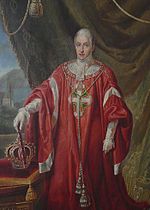
- Emmanuel Philibert, Duke of Savoy (1572–1580)
- Charles Emmanuel I, Duke of Savoy (1580–1630)
- Victor Amadeus I, Duke of Savoy (1630–1637)
- Francis Hyacinth, Duke of Savoy (1637–1638)
- Charles Emmanuel II, Duke of Savoy (1638–1675)
- Victor Amadeus II of Sardinia (1675–1731)
- Charles Emmanuel III of Sardinia (1732–1773)
- Victor Amadeus III of Sardinia (1773–1796)
- Charles Emmanuel IV of Sardinia (1796–1802)
- Victor Emmanuel I of Sardinia (1802–1824)
- Charles Felix of Sardinia (1824–1831)
- Charles Albert of Sardinia (1831–1849)
- Victor Emmanuel II of Italy (1849–1878)
- Umberto I of Italy (1878–1900)
- Victor Emmanuel III of Italy (1900–1946)
- Umberto II of Italy (1946–1983)
- Vittorio Emanuele, Prince of Naples (1983–2024)
- Emanuele Filiberto, Prince of Venice (2024–present)
Recipients in selection
[edit]
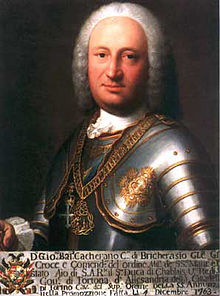

Monarchs
[edit]- Franz Josef I, Emperor of Austria
- Wilhelm II, German Emperor
- Nicholas II, Emperor of Russia
- Gojong, Emperor of Korea
- Haile Selassie, Emperor of Ethiopia
- Zog I, King of the Albanians
- George V, King of the United Kingdom
- Mozaffar ad-Din Shah Qajar of Shah of Persia
- H.M.E.H. Servant of God Fra' Andrew Bertie, Prince and Grand Master of the Sovereign Military Order of Malta
- Maharaja Jagatjit Singh
- Maharaja Juddha Shumsher Jang Bahadur Rana
- Mihailo Obrenović of Serbia
- Abbas I, Wāli of Egypt
Military
[edit]- General of the Armies John Pershing
- General of the Army George Marshall
- Field Marshal Walther von Brauchitsch
- Field Marshal Francisco Solano López
- General Matthew Bunker Ridgway
- General François d'Astier de La Vigerie
- General Tasker H. Bliss
- General Mark W. Clark
- General Ira C. Eaker
- General Peyton C. March
- Admiral Ernesto Burzagli[10]
- Surgeon Rear-Admiral Arthur Skey
- Major General Ulysses S. Grant III
- Major General Mason Patrick[11]
- General Sebastiano Visconti Prasca
- Rear Admiral Richard Byrd
- Brigadier General Billy Mitchell
- Naval Captain Emilio Faà di Bruno
- Flight Commander Douglas Harries
- SS-Obergruppenführer Hans Lammers
- Field Marshal Plaek Phibunsongkhram
- Brigadier General Evan M. Johnson[12]
- Brigadier General Walter McCaw[13]
- Rear Admiral Charles R. Train[14]
Politics
[edit]- Diplomat Isaac Artom
- Tomáš Garrigue Masaryk, 1921
- Enrico d’Arienzo, Prefect of Caltanisetta 1925
- Henri Jaspar
- Charles, 1st Count de Broqueville
- Charles Rogier
- Edmond, Baron de Sélys Longchamps
- President Porfirio Díaz
- Dr Hans Frank, 26.9.1936[15]
- Minister of foreign affairs Giustino Fortunato[16]
- Member of Parliament Cristiana Muscardini
- Diplomat Jose Maria Quijano Wallis[17]
- Luigi, Count Cibrario
- Oswald, Freiherr von Richthofen, State Secretary for Foreign Affairs of the German Empire - August 1902 - during the visit to Germany of King Victor Emmanuel III of Italy[18]
- President of the 1904 Louisiana Purchase Exposition and Former St. Louis Mayor David R. Francis[19]
- Mayor Rudolph Giuliani of New York City (2001) Cavaliere di Gran Croce (Motu Proprio)[20]
- Aldo Oviglio, Minister of Justice (1922–1925)
- James Charles Risk of New York City, Cavaliere di Gran Croce,[21] originally inducted by the last reigning King of Italy, Umberto II of Italy
- Benito Mussolini, Prime Minister of Italy and Duce of Fascism
- Francesco Ruffini, Italian jurist, historian, politician and antifascist.
Culture
[edit]- Architect Carlo Rainaldi
- Architect Giovanni Battista Meduna and his brother, engineer Tommaso Meduna[22]
- Sculptor Christopher Ross
Priests
[edit]- Pietro Tacchi Venturi
- Agostino Cardinal Rivarola
- Blessed Tommaso Reggio
- Timothy Michael Cardinal Dolan
- Désiré-Félicien-François-Joseph Cardinal Mercier
- Blessed Andrea Carlo Cardinal Ferrari
Sciences
[edit]Philanthropy
[edit]Recipients (amongst others)
[edit]- Emanuele Filiberto of Savoy, Prince of Venice, Knight Grand Cross
- Clotilde Courau, Princess of Venice
- Princess Vittoria of Savoy, Princess of Carignano Marchioness of Ivrea
- Princess Luisa of Savoy
- Marina Doria, Princess of Naples and Duchess of Savoy
- Princess Maria Pia of Bourbon-Parma
- Princess Maria Gabriella of Savoy
- Princess Maria Beatrice of Savoy
- Prince Dimitri of Yugoslavia
- Prince Michael of Yugoslavia
- Prince Sergius of Yugoslavia
- Princess Helen of Yugoslavia
- Princess Diana Elizabeth D'Hauteville
- Nicholas, Crown Prince of Montenegro
- Prince Carlo, Duke of Castro
- H.S.H. Mariano Hugo, Prince of Windisch-Graetz Knight Grand Cross
- H.S.H. Don Alessandro Jacopo Boncompagni Ludovisi Altemps Knight Grand Cross
- Don Paolo Thaon di Revel Vandini Knight Grand Cross
- Don Enrico Sanjust dei Baroni di Teulada Knight Grand Cross
- Prof. Alberto Bochicchio Knight Grand Cross
- Don Carlo Buffa dei Conti di Perrero Knight Grand Cross
- Don Giuseppe dei Conti Rizzani Knight Grand Cross
- Don Giancarlo dei Duchi Melzi d'Eril Knight Grand Cross
- Don Andrea dei Conti Boezio Bertinotti Alliata
- Giovanni Cheli Grand Cross
- Antonio d’Amelio Grand Cross
- Monsignor Paolo de Nicolò Grand Cross
- Nicolas Gagnebin Grand Cross
- Theo Niederhauser Grand Cross
- Andrea Rivoira Grand Cross
- Franca Sciaraffia Grand Cross
- Luigi Acquaviva Grand Officer
- Alberto Di Maria Grand Officer
- Giuseppe Resnati Grand Officer
- Zina Losapio Dame
- Alberico Guerzoni
- Alessandro Santini
See also
[edit]- List of Italian orders of knighthood
- Dynastic order of knighthood
- Order of Merit of the Italian Republic
References
[edit]- Miller, Michael (2015). Leaders Of The Storm Troops Volume 1. England: Helion & Company. ISBN 978-1-909982-87-1.
Notes
[edit]- ^ "THE DYNASTIC ORDERS". Dynastic Orders of the Royal House of Savoy.
- ^ "Order of Saint Lazarus: Primary sources" (PDF). um.edu.mt. Retrieved 22 August 2023.
- ^ "About Savoy Foundation". SAVOYFOUNDATION-USA.ORG. Retrieved 22 August 2023.
- ^ "Orders connected to the Order of St. John of Jerusalem". www.orderstjohn.org. 18 December 2023. Archived from the original on 28 October 2007.
- ^ a b c "ITALY". www.haileybury.com.
- ^ Established by Royal Magistral Patent dated 19 July 1839, approved by Royal Decree of 21 December 1924 and renewed by Law No. 203(1) of 7 March 1954 Medaglia Mauriziana al Merito di dieci lustri di carriera militare, published in Gazzetta Ufficiale, No. 116, 21 May 1954, as amended by Law No. 1327 of 8 November 1956
- ^ Ordini Cavallereschi del Regno d'Italia Archived 2006-05-07 at the Wayback Machine Corpo della Nobiltà Italiana (retrieved 10 September 2009)
- ^ Ordine dei Santi Maurizio e Lazzaro Statuto - website of the Grand Magistracy of the Dynastic Orders of the House of Savoy
- ^ a b Cavicchioli, Silvia (1 November 2002). "Strategie nobiliari di sopravvivenza tra Napoleone e Casa Savoia. I Ferrero della Marmora, 1798-1815". Italies (6): 117–143. doi:10.4000/italies.1563. ISSN 1275-7519.
- ^ Senato della Repubblica: biographical summary
- ^ Head, William Pace (1995). Every Inch a Soldier: Augustine Warner Robins and the Building of U.S. Airpower Volume 37 of Texas A & M University military history series. Texas A&M University Press, 1995: Issue 37, p. 75 ISBN 0890965900, 9780890965900 https://books.google.com/books?id=5utyzXwyh1MC&dq=italian+order+of+st.+maurice+and+st.+lazarus+%22mason+patrick%22&pg=PA75 Retrieved November 2, 2012.
- ^ "Gen. Evan M. Johnson". The Philadelphia Inquirer. Philadelphia, PA. 14 October 1923. p. B25 – via Newspapers.com.
- ^ Davis, Henry Blaine Jr. (1998). Generals in Khaki. Raleigh, NC: Pentland Press. p. 250. ISBN 978-1-57197-088-6.
- ^ "Wins Medal While Serving in Adriatic Sea". The Honolulu Advertiser. 11 April 1938. p. 15. Retrieved 21 August 2022 – via Newspapers.com.

- ^ Miller 2015, p. 452.
- ^ Collezione delle Leggi e de'Decreti Reali del Regno delle Due Sicilie, Stamperia reale, 1846, p.85
- ^ "Papel Periódico Ilustrado Volúmen 1 año I Número 1 al 14". Archived from the original on 3 December 2013.
- ^ "Latest intelligence - The King of Italy in Berlin". The Times. No. 36859. London. 29 August 1902. p. 3.
- ^ Lab, Missouri Historical Society. "Missouri Historical Society - Find Yourself Here". The Missouri Historical Society is ... Missouri Historical Society and was founded in 1866.
- ^ "Events: 2001". House of Savoy. Retrieved 1 April 2009.
- ^ "Tricolore 10 Febbraio, 2006" (PDF). Tricolore of Italy reporting on the Ballo di Savoia. Retrieved 17 September 2019.
- ^ Ordine dei Santi Maurizio e Lazzaro (1870). Elenco alfabetico dei decorati dell'Ordine dei SS. Maurizio e Lazzaro dal 17 marzo 1861 (proclamazione del Regno d'Italia) al 31 dicembre 1869 (in Italian). Stamperia Reale. p. 113.
- ^ Ruffy, G., ed. (1924). Qui êtes-vous? Annuaire des contemporains: notices biographiques. 1908-1908/10, 1924. Paris: Librairie Delagrave. p. 741.


 French
French Deutsch
Deutsch



